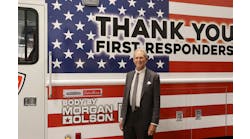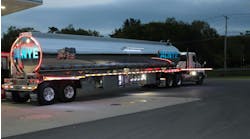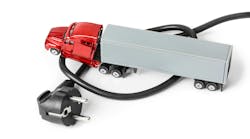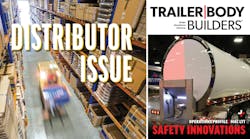Trailer dealers looking for new opportunities might consider adding truck bodies and truck equipment to their inventory—but there is a learning curve to buying, assembling, and servicing lines from this huge and growing market, as explained in a dealer education session ahead of the exhibition opening at the 2024 NATDA Trailer Show.
“Everybody here today is looking for a way to grow their trailer dealership,” Joe Lewis, of Mississippi-based Lewis Trailer Sales, began. “As everybody knows, the trailer industry has seen a slight decline over the last 24 to 36 months. So what we’ve put together here today is a way for you to diversify your dealership.”
Lewis, an NTEA board member and former GM for a leading truck bed manufacturer, knows the truck equipment business—and he outlined the major equipment categories and market sizes: Flat deck bodies, a $450 million market, with about 100,000 new bodies built each year; service bodies, $1.8 billion, also with about 100,000 new bodies built each year; and dump bodies, which come in at almost $1.2 billion, are “a pretty neat” addition for trailer dealers, because of the number of dump trailers already being sold the trailer space today—so “it’s an easy body to upfit.” Similarly, landscape bodies dovetail nicely with landscape trailers for dealers who already have products and customers in that space.
Indeed, Lewis emphasized the importance of cross-selling opportunities and the potential for improved service department utilization by diversifying the business.
“If you’re selling to commercial customers today in your trailer business, many of those commercial customers have service bodies, platforms and flatbeds on their trucks—it’s another way to service those customers,” Lewis said. “And just like trailer customers need truck equipment, truck equipment customers need trailers.”
Learning about chassis, parts
Among the NATDA audience, the most compatible truck equipment will be for trucks in the Class 1-5 range, so trailer dealers need to develop relationships with the auto dealerships in their area who sell pickups.
“Nine out of 10 successful truck-body dealers or upfitters have great relationships with their local and regional auto dealers,” Lewis said. “Commercial customers have multiple trucks, and they need bodies.”
Likewise, truck bodies typically need additional gear—and that means more parts and service opportunities.
“Every truck body, whether it’s a crane body, a dump body or service body, needs parts. Does anybody in here not want to sell more parts?” he continued. “You’re going to plug parts onto 95% of the truck beds you sell. Even if you’re sub-dealing them to somebody, they’re still going to need wiring harnesses, install kits, mudflaps, mudflap brackets—so a lot of opportunities.”
And while trailer dealers often express concern about the amount of investment in parts inventory needed to get into truck upfitting and sales, Lewis downplayed the worry.
“The neat thing about truck equipment is you really don’t have to add that much inventory,” he said. “You have to utilize what you already have, whether it’s ratchet straps or wiring. Buyers toolboxes are always a popular add-on to truck beds and truck equipment. You’re shifting the focus in your service shop from repairs to installs.”
A typical body install job will take four to seven hours, depending on the equipment and complexity, and will bring in $800-$1,000, Lewis noted.
“When you’re getting that kind of revenue off of an install, that certainly is a good utilization piece for your service shop,” he said. “And when you look at the installation time of aftermarket accessories, the interesting piece is your service shop already knows how to install toolboxes. You already know how to put in shelves and drawers and ladder racks. You’re doing that on landscape trailers. You’re doing that on equipment trailers. You’re already doing the work and you already have those parts.”
Getting started
A key difference between trailers and bodies, however, is that truck equipment is part of a certified motor vehicle, and often subject to federal motor vehicle safety rules and regulations.
“Many trailer dealers get into truck beds and they start installing a few flat decks or a few service bodies, and then one of their customers gets in a wreck,” Lewis said. “Then a lawyer gets involved and says, ‘Well, is the truck certified? Does it even have a final stage verification label on it?’ And the trailer dealer knew nothing about it.”
Lewis outlined the different types of certifications available for final stage manufacturers, altered vehicles, and modifications—and these can be daunting to anyone unfamiliar with the standards and how they’re applied.
Read more: The Trailer Show sets records ... again
The good news: NTEA—the Work Truck Association is available to help. The organization, which puts on Work Truck Week every March and also works in Washington on behalf of the work truck industry, is critical to truck equipment upfitters because of its technical expertise and support for members. NTEA staff provide guidance on insight on chassis, equipment design, and model year changes in trucks, as well as data on market size and trends.
Lewis emphasized the critical importance of the NTEA WorkTruckCert program, designed to streamline the completion and printing of certification labels.
The system archives vehicle records and helps companies document conformance with NHTSA-required safety standards as well.
NTEA also publishes the Commercial Vehicle Certification Guide, a representation of compliance mandates and implications facing work truck industry companies in North America.
“If you see a truck in the show this week and it doesn’t have a decal on the door panel that’s been put on by the upfitter, it’s not certified,” Lewis explained. “That’s not a big issue until something happens, and then when that happens, it’s normally not pretty. If a customer goes to a Ford dealership and buys a brand new vehicle and they send it to you to put a body on, you are altering a new vehicle—and there’s an altered label that goes in the door panel. You can print all this off through WorkTruckCert; it’s very, very easy to do. You just have to take 15-30 minutes and complete the checklist of things that certify the upfit.
“All of this can be fairly easily learned but, like anything else, it takes time and investment and knowledge. The NTEA does offer that resource, and it will help you to have safer and more complete upfits.”
How to ‘win’ in truck equipment
As with trailers, there are ins and outs to the choices made by the manufacturer in design and materials, as well as dealer issues such as lead times, ease of installation, floorplan options, and financing. Lewis outlined the basic truck body types and key features to consider when selecting which brand will best serve the local market as well as the needs of the dealership.
Flat beds are “fundamentally different” from brand to brand, Lewis pointed out. So dealers should consider:
- Headache rack style
- Hitch capacity
- Wiring
- Deck thickness
- Toolbox door/latch configuration
Service bodies can be a more complex body to sell, Lewis suggested. However, the market is larger, as are revenues and returns. Things to consider include:
- Base material
- Door configuration
- Floor thickness
- Aftermarket accessories
- Wiring
For dump bodies, Lewis noted that they are an easy add-on to a trailer dealership since many customers transition to dumps so they can tow equipment using only one vehicle. Otherwise, things to consider include:
Base material
- Coating
- Floor thickness
- Understructure
- Hoist capacity
Landscape bodies are a growing business for truck equipment upfitters due to their ease of maneuverability when compared to trailers in neighborhoods, Lewis suggested. A few things to consider for landscape units include:
- Base material
- Coating
- Floor thickness
- Storage features
- Freight
In mentioning the difference between the trailer dealer’s NATDA member work with truck and truck equipment manufacturers, the latter are likely to be “more professionalized” and safety focused than a lot of trailer builders.
“Most truck equipment manufacturers can be more mature,” Lewis said. “You have to be, because when a cop pulls you over with a truck that’s wrong. it’s a big deal.”
Finally, doing the math, Lewis got the attention of dealers with his basic slide showing the revenue attached to truck equipment and upfitting.
“We developed this slide several years ago, to just give you an idea,” Lewis advised. “It’s a certainly an estimate. There’s no scientific method to this.”
Based on just two flat decks per week, or just over 100 per year, the revenue from body sales would be $676,000; install revenue would be $93,600, parts would come in at $31,200, for total incremental revenues of $800,800. The numbers go up accordingly, climbing to $2.4 million for six bodies per week.
“So, on a truck equipment body you should be able to make 20% very consistently,” Lewis said. “If you’re looking at parts, hopefully you’re making more than that. So your parts sales will certainly spike, and utilization of service will be exponential to your business.”
But for many trailer dealers, they still can’t know what they don’t know about truck equipment until they try it—and that could be expensive.
Again, Lewis points to the resources available through NTEA.
“Go to the Work Truck Show in Indianapolis: That’s a good place for trailer dealers to spend a day or two and meet manufacturers and go to classes,” Lewis concluded. “It’s hard to take every dealer through everything, but you can expose them to things that could help them and that is super important.”










